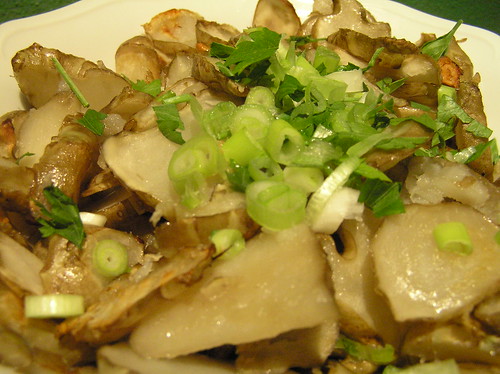
Jerusalem Artichoke by mightyjoepye
I planted these sunchokes in the Spring and now the stalks are almost 5 feet tall. Do I remember that they eventually have a yellow flower or do I just wait and dig them up in November?
Jerusalem artichokes, Helianthus tuberosus, otherwise known as sunchokes, bloom late in the summer and into the fall. They are a native of North America related to the sunflower. They are not related to Jerusalem or an artichoke. The story about how the plant got its name starts when French explorer Samuel de Champlain got them from the North American natives and thought they tasted like artichokes. He sent the them to Europe to grow. The Italians called them girasole articiocco, meaning “sunflower artichoke”because of the taste. Americans thought girasole sounded like “Jerusalem,” so this name became one of the common names of the plant.
Jerusalem Artichokes (Helianthus tuberosus), also called the sunroot or sunchoke or earth apple or topinambur by Ian A Kirk
Jerusalem artichokes or sunchokes are very easy to grow in zones 3 through 9 in almost any loose, moderately well drained soil in sun or partial shade. They spread easily and can become invasive, so some people consider them a weed. They like regular watering but can tolerate some drought. They grow up to 8 feet tall so plant them in the back of the garden. Butterflies and songbirds enjoy the flower. And the tubers are good eating either raw or cooked, low in calories and good for people with diabetes. Use a brush to scrub off the dirt. If you cook the chokes, you can prepare them as you would any potato recipe.
In the fall, at least 2 weeks after the flowers have faded you can start harvesting the tubers but it is best to wait as late as possible before the ground freezes too hard that digging is a chore. This is the best time to start digging up your tuber harvest; it is best to wait till at least after the first hard freeze or two, because–as with many root crops– the flavor of sunchokes is improved by a freeze or two, plus they do most of their growing in late autumn. Alternatively, you can just leave the tubers in the ground right through the winter, then dig them up as soon as the ground unfreezes enough in spring: some suggest that the tubers taste even better after fully overwintering.


